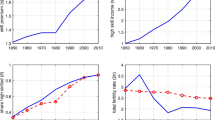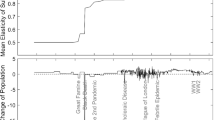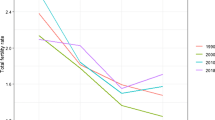Abstract
Developing countries with highly unequal income distributions, such as Brazil or South Africa, face an uphill battle in reducing inequality. Educated workers in these countries have a much lower birthrate than uneducated workers. Assuming children of educated workers are more likely to become educated, this fertility differential increases the proportion of unskilled workers, reducing their wages, and thus their opportunity cost of having children, creating a vicious cycle. A model incorporating this effect generates multiple steady-state levels of inequality, suggesting that in some circumstances, temporarily increasing access to educational opportunities could permanently reduce inequality. Empirical evidence suggests that the fertility differential between the educated and uneducated is greater in less equal countries, consistent with the model.
Similar content being viewed by others
References
Barro, R., and X. Sala-i-Martin. (1995). Economic Growth. New York: McGraw-Hill.
Birdsall, N. (1988). “Economic Approaches to Population Growth,” in Chenery, H., and Srinivasan, T.N., eds., Handbook of Development Economics, vol. 1. Amsterdam: Elsevier Science Publishers, pp. 477–542.
Chen, D. L. (1999). “Income Distribution Dynamics with Endogenous Fertility,” Senior Thesis, Harvard University.
Chu, C. Y. C., and H.-W. Koo. (1990). “Intergenerational Income-Group Mobility and Differential Fertility,” American Economic Review 80(5), 1125–1138.
Dahan, M., and D. Tsiddon. (1998). “Demographic Transition, Income Distribution, and Economic Growth,” Journal of Economic Growth 3(1), 29–52.
Deininger, K., and L. Squire. (1996). “Measuring Income Inequality: A New Data-base.” Development Discussion Paper No. 537, Harvard Institute for International Development, Harvard University.
Galor, O., and J. Zeira. (1993). “Income Distribution and Macroeconomics,” Review of Economic Studies 60(1), 35–52.
Galor, O., and H. Zang. (1997). “Fertility, Income Distribution, and Economic Growth: Theory and Cross-Country Evidence,” Japan and the World Economy 9(2), 197–229.
Jones, E. (1982). Socio-economic Differentials in Achieved Fertility. World Fertility Survey Comparative Study No. 21, ECE Analyses. Voorburg, The Netherlands: International Statistical Institute.
Kremer, M., and D. Chen. (2000). “Income Distribution Dynamics with Endogenous Fertility,” NBER Working Paper No. 7530.
Krusell, P., L. Ohanian, V. Rios-Rull, and G. Violante. (1997). Capital-Skill Complementarity and Inequality: A Macroeconomic Analysis. Federal Reserve Bank of Minnesota Staff Report #239.
Lam, D. (1986). “The Dynamics of Population Growth, Differential Fertility, and Inequality,” American Economic Review 76(5), 1103–1116.
Mare, R. D. (1997). “Differential Fertility, Intergenerational Educational Mobility, and Racial Inequality,” Social Science Research 26(3), 263–291.
Mboup, G., and T. Saha. (1998). Fertility Levels, Trends, and Differentials: Demographic and Health Surveys, Comparative Study No. 28. Calverton, Maryland: Macro International.
Moav, O. (2001). “Cheap Children and the Persistence of Poverty.” Mimeo.
Morand, O. (1999). “Endogenous Fertility, Income Distribution, and Growth,” Journal of Economic Growth 4(3), 331–349.
Nei cheng pu. (1996). Chung-hua min kuo Tai Min ti chu jen kou tung chi. Taiwan-Fukien demographic fact book, Republic of China, Tai-pei.
Nerlove, M., A. Razin, and E. Sadka. (1984). “Income Distribution Policies with Endogenous Fertility,” Journal of Public Economics 24(2), 221–230.
Preston, S., and C. Campbell. (1993). “Differential Fertility and the Distribution of Traits: the Case of I.Q,” American Journal of Sociology 98(5), 997–1019.
Razzaz, S. (1998). “Fertility and Growth: The Significance of Gender Differences in Human Capital.” Unpublished Ph.D. dissertation, Brown University.
Repetto, R. (1978). “Interaction of Fertility and Size Distribution of Income,” Journal of Development Studies 14(4), 22–39.
Schultz, T. P. (1981). Economics of Population. Massachusetts: Addison-Wesley.
Summers, R., and A. Heston. (1991). “The Penn World Table (Mark 5): An Expanded Set of International Comparisons, 1950–1988,” Quarterly Journal of Economics 106(2).
United Nations. (1987). Fertility Behavior in the Context of Development: Evidence from the World Fertility Survey. Population Studies No. 100, New York: United Nations, 1987.
United Nations. (1995). Women's Education and Fertility Behavior: Recent Evidence From the Demographic and Health Surveys. New York: United Nations.
World Bank. (1999). World Development Report 1999/2000. Oxford: Oxford University Press.
Author information
Authors and Affiliations
Rights and permissions
About this article
Cite this article
Kremer, M., Chen, D.L. Income Distribution Dynamics with Endogenous Fertility. Journal of Economic Growth 7, 227–258 (2002). https://doi.org/10.1023/A:1020154031908
Issue Date:
DOI: https://doi.org/10.1023/A:1020154031908




